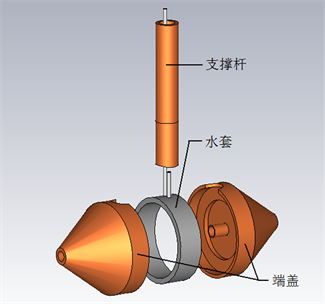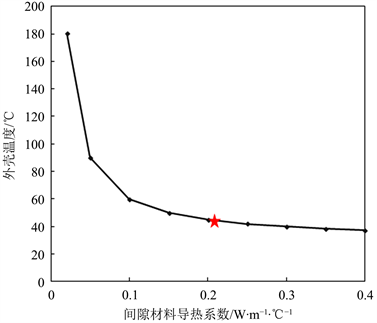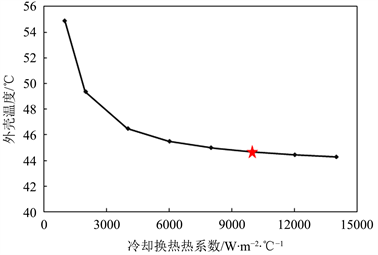摘要: 中国散裂中子源(China Spallation Neutron Source, CSNS)漂移管直线加速器(Drift Tube Linac, DTL)由4台9米长腔筒、161台漂移管及其他高频部件构成,负责把负H离子由3 MeV加速到80 MeV。漂移管外壳采用全无氧铜电子束焊接而成,壳内有独立的不锈钢水套,外壳和水套采用间隙装配,其间有约0.2 mm间隙填充环氧介质。外壳的高频热功率约200 W,为了降低外壳温度及减小失谐量,冷却十分重要,外壳靠水套冷却,冷却效果不仅与0.2 mm间隙介质的导热系数有关,还与水套的冷却换热系数有关。利用3D软件Workbench仿真分析间隙介质导热系数和水套冷却换热系数对漂移管外壳温度的影响,间隙介质的导热系数大于0.1 W∙m
−1∙℃
−1时,冷却效果较好且外壳温度随介质导热系数变化不大,介质导热系数小于0.1 W∙m
−1∙℃
−1时,随着导热系数的减小,外壳的温度会急剧升高,因此选择导热系数在0.2 W∙m
−1∙℃
−1以上的环氧树脂填充间隙,另外,为了达到较好的冷却效果,水套中的冷却水应该处于湍流状态,流量应大于1.8 L/min,冷却换热系数大于5500 W∙m
−2∙℃
−1,漂移管实际运行中水套流量选择4 L/min,冷却换热系数约为10,000 W∙m
−2∙℃
−1,外壳温度较低,失谐量较小,运行具有较高的可靠性和稳定性。
Abstract:
Drift Tube Linac (DTL) which can provide energy gain from 3 MeV to 80 MeV is used in China Spalla-tion Neutron Source (CSNS), the DTL consists of 4 9 m-long cavities, 161 drift tubes and other com-ponents. The drift tube shell is made of oxygen free copper and welded by electron beam welding (EBW), there is an independent water jacket which has been assembled with about 0.2 mm clear-ance in the shell for cooling, the clearance is filled with epoxy. Under the 200 W high frequency thermal power, the cooling of drift tube shell is very important for reducing shell temperature and detuning. The shell temperature is not only related to the thermal conductivity of the 0.2 mm clearance medium, but also related to the heat transfer coefficient of the water jacket. With 3D code Workbench, the influence of thermal conductivity of the gap medium and heat transfer coefficient of the water jacket on the drift tube shell temperature is analyzed. When the thermal conductivity of the medium is greater than 0.1 W∙m−1∙˚C−1, the cooling effect is good, and the shell temperature does not change with the thermal conductivity of the medium, otherwise, the temperature of the shell will rise sharply with the decrease of the thermal conductivity. Therefore, the epoxy resin with the thermal conductivity above 0.2 W∙m−1∙˚C−1 is selected to fill the clearance. Moreover, in order to achieve better cooling effect, the cooling water in the water jacket should be in turbulent state, the flow rate should be greater than 1.8 L/min, and the heat transfer coefficient should be greater than 5500 W∙m−2∙˚C−1. In actual operation, the flow rate of the water jacket is 4 L/min, and the heat transfer coefficient is about 10,000 W∙m−2∙˚C−1. The drift tube shell temperature and detuning keep low and operating under high reliability and stability.
1. 引言
中国散裂中子源(China Spallation Neutron Source, CSNS)是国家为解决重大科技前沿、国家战略需求中的战略性、基础性和前瞻性科技问题,谋求重大突破而投资建设的大型研究设施 [1] [2]。CSNS是由一台负H直线加速器、一台快循环同步加速器、一个靶站和三台谱仪构成。加速器离子源产生负H离子束流,通过射频四极加速器聚束和加速后,由漂移管直线加速器把束流能量进一步提高到80 MeV,负H离子经剥离成质子后注入到一台快循环同步加速器中并加速到1.6 GeV,质子打靶产生中子经过慢化并引向谱仪供用户开展实验 [3] [4]。其中,漂移管直线加速器(Drift Tube Linac, DTL)负责把负H离子由3 MeV加速到80 MeV,其内部结构如图1所示,DTL总长度约36米,由4节物理腔、161台漂移管、4台功率耦合器、56台调谐器、133台耦合杆构成 [5],另外DTL配有一套复杂的水冷系统用来冷却其高频部件,一套真空系统来维持加速器的高真空度。

Figure 1. Structural of drift tube linac
图1. 漂移管直线加速器实物图
漂移管是DTL的核心部件,由一台电四极聚焦磁铁和外壳构成,漂移管的外壳结构如图2所示,包括支撑杆、两个端盖和芯管,外壳采用全无氧铜材质,通过电子束焊接成型 [6]。外壳由一个独立不锈钢水套冷却,水套与端盖采用间隙配合工艺,其间有约0.2 mm的间隙,间隙通过真空浇注填充环氧树脂,增强导热性。

Figure 2. Structure of drift tube shell
图2. 漂移管外壳结构
2. 影响漂移管外壳温度因素分析
漂移管工作在占空比为1.625%的脉冲功率下,外壳的高频发热平均功率约为两百瓦 [7],靠不锈钢水套冷却。水套与无氧铜外壳采用间隙装配,间隙要填充材料以起到固定和增大导热作用。间隙材料的导热系数对外壳温度有很大影响,如图3所示,当导热系数小于0.1 W∙m−1∙℃−1时,漂移管外壳温度较高且随着导热系数的减小外壳温度会迅速升高,当导热系数大于0.1 W∙m−1∙℃−1时,漂移管外壳冷却效果较好,外壳温度较低且温度随着导热系数的变化变化很小。因此,漂移管选择导热系数大于0.2 W∙m−1∙℃−1的环氧树脂填充间隙,冷却效果好且有较好的固定作用。

Figure 3. The variation of temperature of drift tube shell with thermal conductivity of clearance medium
图3. 漂移管外壳温度随间隙材料导热系数的变化
漂移管外壳温度还受水套冷却换热系数的影响,如图4所示,冷却换热系数对壳体温度的影响与间隙导热系数对壳体温度的影响趋势相似,在低值区影响较大,整体看冷却换热系数对壳体温度的影响较弱些。水套冷却管道为并联的3路3 mm × 5 mm的矩形管道,为了达到较好的冷却效果,水套中的冷却水应该处于湍流状态,对应总流量应大于1.8 L/min,冷却换热系数大于5500 W∙m−2∙℃−1,从图4可以看到,冷却换热系数在5500 W∙m−2∙℃−1以上时,壳体冷却效果很好。另外,漂移管实际运行中水套流量选择4 L/min,冷却换热系数约为10,000 W∙m−2∙℃−1湍流状态,有充足的冗余来保证漂移管运行的稳定。

Figure 4. The variation of temperature of drift tube shell with heat transfer coefficient
图4. 漂移管外壳温度随冷却换热系数的变化
3. 漂移管外壳温度
利用3D软件Workbench仿真分析了外壳温度 [8],如图5所示,外壳最高温度45℃,由于仿真模拟只考虑了水套的冷却作用,忽略了壳体的热辐射以及其它结构的传导热,实际外壳的温度要小于仿真计算结果,漂移管外壳冷却良好,失谐量较小。

Figure 5. Temperature of drift tube shell
图5. 漂移管外壳温度
随着DTL漂移管的长期运行,少量低能段漂移管出现由于水套冷却管道堵塞而导致的不同程度的流量下降,流量由4 L/min下降到最低1.5 L/min,冷却水处在接近湍流的中间状态,冷却换热系数约为4800 W∙m−2∙℃−1,由于低能段漂移管外壳高频发热功率也相对小一些 [7],漂移管外壳的温度不会太高而增大失谐量进而影响DTL运行。另外,有一台漂移管的间隙导热系数严重下降 [9],预估已经降到0.05 W∙m−1∙℃−1以下,漂移管外壳温度达到100℃以上,失谐量较大,一定程度上影响了漂移管的运行,待进一步分析解决。
4. 总结与展望
介绍了中国散裂中子源的漂移管直线加速器及漂移管外壳结构,仿真分析了影响漂移管外壳温度的两个因素间隙材料导热系数和水套冷却换热系数。间隙材料导热系数应大于0.1 W∙m−1∙℃−1,水套冷却水流量应大于1.8 L/min,即冷却换热系数大于5500 W∙m−2∙℃−1,漂移管外壳可较好地被冷却。漂移管实际选择了导热系数大于0.2 W∙m−1∙℃−1的环氧树脂作为间隙材料,水套冷却流量4 L/min,有良好的冷却且充足的冗余保证漂移管稳定运行,仿真计算漂移管外壳运行温度45℃。另外,对于一些随着长期运行外壳冷却变差的漂移管,本文提供了研究分析的方法和解决问题的指导。